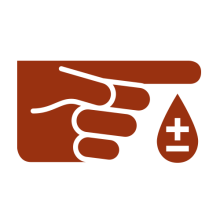Diabetes
1 in 11 people in Wisconsin have diabetes
Diabetes affects how your body turns food into energy.
Most of what we eat is broken down into sugar (or glucose) and enters our bloodstream. The pancreas makes a hormone called insulin that lets blood sugar into our cells for energy.
If you have diabetes, your body doesn't make enough insulin, or can't use available insulin as well as it should. When this happens, too much sugar stays in your bloodstream, which can lead to serious health problems.
Here are the most common types of diabetes:
- Type 1 diabetes is caused by an autoimmune reaction (where the body attacks itself by mistake) so insulin isn't made anymore. About 5% of people with diabetes have type 1. Type 1 is most often seen in children and young adults. People with type 1 diabetes need insulin injections to keep blood sugar levels healthy.
- Type 2 diabetes occurs when your body doesn't use insulin well. It can lead to serious health problems like heart attack, stroke, blindness, kidney failure, and loss of toes, feet, or legs. Two out of five adults are expected to develop type 2 diabetes in their lifetime. People with type 2 diabetes may take pills, insulin, other injectable diabetes medication, or a combination of medication to keep blood sugar levels healthy.
Gestational diabetes develops in pregnant women who have never had diabetes before. Every year, 2% to 10% of pregnancies are affected by gestational diabetes. If you have gestational diabetes, it usually goes away after your baby is born, but greatly increases your risk and your baby's risk of having type 2 diabetes later in life.
If blood sugar levels stay high or above goal, Type 1 and type 2 diabetes can lead to serious health problems like heart attack, stroke, blindness, kidney failure, loss of toes, feet, or legs, hearing loss, and problems with the digestive system. Making healthy food choices and regular physical activity can help people with type 1, type 2, and gestational diabetes stay healthy.
For more information on types of diabetes, visit the American Diabetes Association Diabetes webpage.
What you can do
Managing your diabetes can be a challenge. Here are a few things that can help:
- Workshops and programs
- Diabetes tools and support - American Diabetes Association recognized diabetes education programs
- Diabetes education is covered by Medicare and most health insurance plans when offered through an accredited program. To find an accredited program near you, visit the Association of Diabetes Care and Education Specialists' Find an Education Program website.
- Healthy Living with Diabetes are evidence-based workshops offered by the Wisconsin Institute for Healthy Aging in English and Spanish.
- Logs and guides. These materials are available at no charge and can be ordered in large quantities by using the F-80025a (Word) form:
- Diabetes Self-Care Guide, P-43081 (also available in Spanish and Hmong for download only) explains how diabetes affects you and what you can do to take care of yourself. There is space in the back to keep track of your diabetes care and set health goals.
- Blood Glucose (Sugar) Log Booklet, P-00246 (also available in Spanish): log your blood glucose (sugar) results each day and use the results to make lifestyle changes. Share your results with your health care providers so they can make changes to your medicine if needed.
- Personal Diabetes Care Record Wallet Card, F-49357 (also available in Spanish): keep your health care team's contact information and most recent lab/exam results in one convenient location.
- American Heart Association's Check. Change. Control. Tracker: keep track of your blood pressure by regularly measuring it at home, and record it using this tracker. It's important for you and your health care provider to track your blood pressure, since having diabetes increases your risk for heart disease
- Don't smoke, or get the help you need to quit. Visit the Wisconsin Tobacco Quit Line or call 800-QUIT-NOW (800-784-8669) to get free access to coaching and medication to help you quit.
- Medication, prescription, Medicare, and benefits assistance
- Needy Meds: information on locating assistance programs for affording medications and health care costs.
- Partnership for Prescription Assistance: free, online resource for uninsured and underinsured individuals to find prescription medications for free or nearly free.
- Managing Health Care Waste: the Wisconsin Department of Natural Resources' website has information on managing health care waste for patients, clinics, schools, and others.
- Managing Household Medical Sharps: the Wisconsin Department of Natural Resources website has information on correct packaging and safe disposal of medical sharps through the Wisconsin Sharps Collection Program.
- The Medigap Helpline (1-800-242-1060) is a toll-free helpline operated by the Wisconsin Board on Aging and Long Term Care that provides free counseling to all Wisconsin Medicare beneficiaries on Medicare, Medicare supplement insurance, employer-based health insurance, Medicare Advantage plans, long-term care insurance, and related topics.
- The Medigap Part D and Prescription Drug Helpline (1-855-677-2783) is a toll-free helpline operated by the Wisconsin Board on Aging and Long Term Care that answers questions from Wisconsin residents aged 60 and over about Medicare Part D and other prescription drug coverage options.
- The Disability Drug Benefits Helpline (1-800-926-4862) is a toll-free helpline operated by Disability Rights Wisconsin that helps people who have Medicare due to a disability with questions about prescription drug coverage.
- Benefit specialists at local Aging Units and Aging and Disability Resource Centers are available in every county to provide individualized counseling and advocacy for adults ages 18 to 59 with disabilities and people age 60 or older. They can assist with Medicare, as well as other public and private benefits issues.
- Office for the Deaf and Hard of Hearing (video phone: 262-347-3045) provides outreach and individual counseling in American Sign Language.
- Wisconsin Judicare, Inc. (1-800-472-1638) provides outreach and benefits counseling to Native American Medicare beneficiaries.
- Wisconsin Lion's Foundation's Diabetes Educational Videos can be viewed on YouTube (below), or ordered by calling 1-877-463-6953 (toll-free)
Resources for the school setting
- American Diabetes Association Training Resources for School Staff. Information and resources on understanding diabetes and diabetes care in the school setting which include school training modules, Diabetes Medical Management Plan, school nurse pump training skills checklist, recommendations for use of continuous glucose monitors in the school setting, insulin guidance for school nurses, tips to help teachers keep kids with diabetes safe at school, and more.
- Managing Diabetes Safely in the School Setting: A Framework for Collaborative Care (PDF) Wisconsin Department of Public Instruction
- Diabetes Management in Schools (School Nursing and Health Services), Wisconsin Department of Public Instruction
- Emergency Action Plan for Students with Diabetes, F-43009 (PDF)
- Diabetes Medical Management Plan, F-43013 (PDF)
Diabetes Camp for Children in Rosholt, Wisconsin
The Wisconsin Lions Camp offers two, one-week sessions for children with diabetes ages 12-16. Kids meet other kids like them, build self-confidence, and learn about healthy lifestyle through education, physical activity, emotional well-being, and glucose control. To learn more please visit wisconsinlionscamp.com or call 715-677-4969.
Know Diabetes by Heart: living with type 2 diabetes puts you at higher risk for heart disease and stroke. Knowing what steps to take may reduce your risk.
Eat Right: Academy of Nutrition and Dietetics: food and nutrition resources from the world's largest organization of food and nutrition professionals
Diabetes Food Hub: American Diabetes Association
National Kidney Foundation of Wisconsin: diabetes, high blood pressure, and family history are the leading causes of chronic kidney disease
Prevent Blindness Wisconsin: if you have diabetes, prevention of eye diseases related to diabetes is a priority
Centers for Disease Control and Prevention: resources for living with diabetes including sick days, managing blood sugar, mental health, and being prepared for emergencies
National Institute of Diabetes and Digestive and Kidney Diseases: resources for diabetes tests and diagnosis, insulin and medications, and preventing problems
American Diabetes Association: resources for all types of diabetes, their friends, family, and people at risk for developing type 2 diabetes
JDRF: resources for people with type 1 diabetes, their friends, and family
What we are doing
The Chronic Disease Prevention Program partners with communities, health systems, health care providers, insurers, and professional organizations to prevent type 2 diabetes and improve diabetes management. Select a topic below to explore our current projects and partnerships.
The Chronic Disease Prevention Program is committed to sharing chronic disease data with Wisconsin communities. Explore maps and data resources by topic on our Maps and Data webpage.
Diabetes Self-Management Education and Support (DSMES) is a critical element of care for all people with diabetes. DSMES is the ongoing process of facilitating the knowledge, skills, and ability necessary for self-care for someone with diabetes. The Chronic Disease Prevention Program supports improved access and participation in DSMES. DSMES is associated with increases in primary service visits and decreases in acute, inpatient hospital visits. Currently, we are working with the Wisconsin Collaborative for Healthcare Quality Chronic Disease Steering Team, the Wisconsin Institute for Healthy Aging, and Milwaukee-based Community Health Workers at Unite WI to increase access to and participation in DSMES programs.
If you'd like to know more about DSMES standards, accreditation and recognition, reimbursement, and more, we encourage using the CDC's DSMES Toolkit.
Community health workers are frontline, culturally competent, public health workers who serve as a bridge between less resourced communities and health care systems. They are from, or have a close understanding of, the community served. We support the advancement of a statewide community health worker network, training and apprenticeships, and engage with the Wisconsin Public Health Association's Community Health Worker Section. We also promote sustainability of care models that engage community health workers in diabetes prevention and management. Collaborative partners include organizations utilizing the Pathways Community HUB Model, like UniteMKE in Milwaukee, and Great Rivers HUB in La Crosse.
Many health systems use electronic health records and health information technology to measure and track clinical quality measures. Our program promotes the adoption of standardized clinical quality measures to prevent and manage diabetes. Additionally, we promote the adoption of these measures to improve monitoring of health and health care disparities among populations, and inform activities to eliminate them. Below are our current partnerships specific to these efforts:
- The Chronic Disease Quality Improvement Project is a collaboration between Wisconsin health plans and the Department of Health Services’ Chronic Disease Prevention Program. The project was established in 1998, with an initial focus on diabetes. Over the years, its scope expanded to include other chronic diseases and their risk factors. Members evaluate and report chronic disease prevention and health care quality measures. They also share information, population-based strategies, and evidence-based approaches to improve care.
- We partner with the Wisconsin Primary Healthcare Association to increase the number of Wisconsin's community health centers using Azara DRVS, a centralized data reporting system that leverages electronic health record data for population health management and quality improvement. We encourage provider-level quality improvement projects that use diabetes management measures found in Azara DRVS. Currently, 12 of 18 community health centers are using this system.
- The Wisconsin Collaborative for Healthcare Quality publicly reports electronic health record-derived performance measures to drive health care quality improvement.
Medication therapy management is a distinct service to ensure the best therapeutic outcomes for patients. It includes five core elements:
- Medication therapy review
- Personal medication record
- Medication-related action plan
- Intervention or referral
- Documentation and follow-up
Medication therapy management has been shown to improve how well people take the medication they are prescribed. We work closely with the Pharmacy Society of Wisconsin and their Wisconsin Pharmacy Quality Collaborative program to engage pharmacists in the promotion of medication therapy management and lifestyle modification for patients with diabetes. The Pharmacy Society of Wisconsin provides interactive training, toolkits, and technical assistance to 250+ accredited pharmacies and nearly 500 certified pharmacists across Wisconsin.




